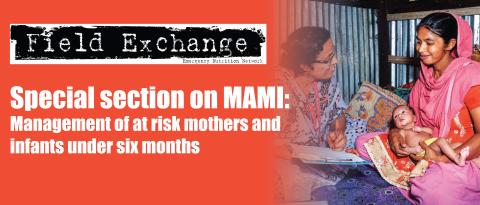Food assistance for nutrition: Evidence Summit
By Lindsey Green
Ongoing food crises around the world underscore the need for effective food assistance (defined as in-kind food aid and/or cash and voucher programming). As the environments in which food assistance is delivered become more complex and challenging, the demand for sound evidence on which to base policy and operational decisions continues to grow. Financial and human resources are limited; it is therefore critically important that actions aimed at cost-effective impacts are informed by rigorous evidence.
An ‘Evidence Summit’ was convened to facilitate dialogue and the sharing of evidence on food assistance of nutrition programming under the auspices of the Food Aid Quality Review (FAQR) project, funded by the United States Agency for International Development (USAID) Office of Food for Peace (FFP). The event took place in Washington DC on 27 and 28 June 2018. Over 250 researchers, policy-makers and representatives from donors, industry and implementing partners gathered to take stock of and critique existing studies and examine critical evidence gaps. A mix of presentations, panel discussions, ‘lightning talks’, demonstrations, discussions and poster/table displays covered the following areas:
- Current evidence on food assistance programming with maternal and child nutrition or micronutrient deficiencies as explicit outcomes of interest;
- Future needs for assistance in terms of the development of nutritionally-enhanced products, programming and optimising resource allocations;
- Cost-effectiveness research;
- Innovations in packaging, ingredients, formulations and processing of food aid products;
- Research methods and metrics to determine nutrition impacts, cost-effective operations, and additional ancillary goals;
- Food aid supply chain optimisation; and
- Food aid safety and quality.
Action items emerged during the meeting, resulting in a set of broadly agreed priorities as discussed below.
As much research attention is needed on the cost-effectiveness of programming modalities as on the efficacy of products
Presenters Patrick Webb (Tufts University), André Briend (University of Tampere and University of Copenhagen) and Nancy Aburto (World Food Programme (WFP)) noted that great strides have been made in the past decade on food assistance research. Much of that work was focused on optimising the composition of food products to meet defined nutrient needs of malnourished children. Multiple innovations in ingredients, formulations and processing were highlighted during the summit to spur a conversation on the continued improvement of product quality. Some important questions regarding composition remain – including both the nutrient-specific requirements for malnourished children and the overall quality of products to ensure nutrient absorption and utilisation.
The presenters also recognised that the scope and type of food assistance evidence generated has shifted recently, moving from food product comparisons towards more comprehensive evaluations of programme implementation. That said, it was recognised that there is still an urgent need for improved empirical evidence on effective programme design and implementation, particularly where multi-sector actions are involved.

The ways we measure success must be refined and possibly expanded
Researchers representing WFP, Tufts University, International Centre for Diarrhoeal Disease Research, Bangladesh (ICDDR,B), and the Institut de Recherche en Sciences de la Santé (IRSS), discussed best practices for improving the quality of research. There was broad agreement that programmes should always plan for rigorous evaluation and, where possible, incorporate sound studies of the facilitators and constraints to effective implementation and achievement of impact. Financial, technical and logistical barriers to robust data collection always exist, but these can be surmounted through innovation, programmatic prioritisation and incorporation of technical expertise from other parts of the humanitarian and private sector.
There was animated conversation on expanding the metrics of impact used, particularly in measuring nutrition and health beyond traditional anthropometric z-scores. It was widely agreed that, while conventional nutrition outcomes are important, good measurement of intermediate steps are also key and a more comprehensive picture of ‘success’ is often needed; i.e., rather than relying on discharge or exit criteria from programming (such as exceeding a cut-off point in weight, weight-for-height, or mid-upper arm circumference (MUAC)), the prevention of relapse into malnutrition requires attention to the sustainability of ‘recovery’. Developing metrics and field-friendly techniques to measure outcomes such as body composition, nutritional biomarkers, cognitive function and long-term productivity or contribution to society are key indicators that should be used and further developed.
It was also widely noted that investments in data analytics and assessment tools can be very helpful to operational stakeholders. Speakers from WFP, USAID, Northeastern University, CapGemini, World Vision International and the UPS Foundation highlighted significant gains that can be made by investing in infrastructure to optimise decision-making along the supply chain and ensuring that the right food assistance products reach the right beneficiary at the right time. The infrastructure for such systems requires upfront investment (which makes it difficult to establish), but there is interest and willingness to use and share data that would make food assistance more efficient and cost-effective.
Multi-sector collaboration is critical across the food assistance ecosystem
Food assistance interventions encompass many actors across multiple sectors, making up an “elegant ecosystem” (Diane Holland, UNICEF). Multi-sector collaboration is necessary to maximise resources and address problems effectively and efficiently, but can be challenging due to differences (e.g., language, operating standards) across actors, requiring continued efforts to enhance collaboration. In addition to multiple actors, the ecosystem of food assistance includes many intervention points along the supply chain. Innovations must be implemented using a ‘systems-thinking perspective’, considering feasibility across stakeholders, beneficiary perspectives and varied implementation contexts.
The food assistance ecosystem can be nurtured through a well-stocked toolbox of food assistance modalities. Evidence on the effectiveness of cash and vouchers in achieving nutrition outcomes from the Cash Learning Partnership (CaLP) and Research on Food Assistance for Nutritional Impact (REFANI) was shared. There is also new evidence on the integration of complementary activities in the programming of food assistance. Further evidence generation is needed in these areas, including how different modalities making up the food assistance ecosystem can work together and complement each other to support improved nutrition outcomes.
Constrained resources require nimble thought and action
Opening and closing keynote speakers Thomas Staal (USAID), Roger Thurow (The Chicago Council) and United States Representative Jim McGovern all noted that food assistance needs are not declining. Despite this, the speakers recognised that there is a lack of evidence on how best to use food assistance in emergencies, as well as how best to transition food assistance from an emergency to development response. These are key research priorities moving forward.
With finite resources, food assistance efforts must be efficient, providing the best value for money; cost effectiveness must therefore always be considered in food aid programming. Results from recent field research and cost-effectiveness modelling from the iLNS, MINIMOD, FAQR, SPRING, ComPAS and FANTA PM2A studies were reviewed. Robust cost-effectiveness evidence should drive policy and programme decision-making. Evidence on how food assistance can be used most efficiently and effectively to achieve nutrition outcomes has come a long way and much has been accomplished. Important research gaps persist and must be prioritised and sufficiently funded. Ultimately, as stated by Representative McGovern, hunger is a political condition and addressing it requires political will and public interest.
Collective learning must continue
There was a clear consensus that continued opportunities for sharing research updates and discussing the implications of emerging evidence on policy and programmes across stakeholder groups is vitally important. Rigorous evidence is clearly in high demand and there must be continued commitment to generating and sharing evidence to achieve common goals.
Materials from the evidence summit can be downloaded here.
For more information, please contact Lindsey Green.


